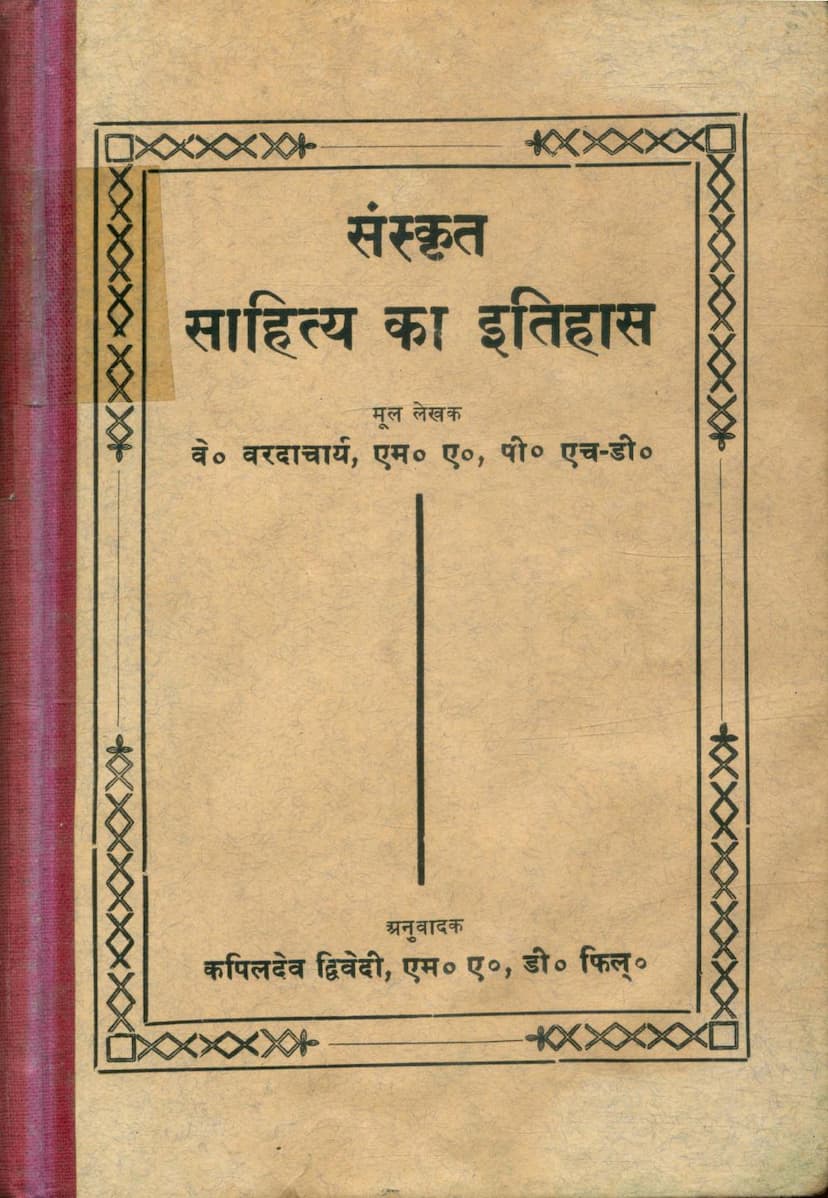Sanskrit Sahitya Ka Itihas
Added to library: September 2, 2025
Loading image...

Summary
This comprehensive summary outlines the content of "Sanskrit Sahitya Ka Itihas" (History of Sanskrit Literature) by V. Vardacharya, translated into Hindi by Dr. Kapildev Dwivedi. The book provides a detailed chronological overview of Sanskrit literature, from its Vedic origins to the 19th century.
Key aspects covered in the book:
- Introduction: Discusses the definition of Sanskrit, its evolution from Vedic to Classical Sanskrit, and its role as a literary and spoken language. It also touches upon the contributions of Western scholars to the study of Indian literature.
- Vedic Period: Explores the Vedas (Rigveda, Yajurveda, Samaveda, Atharvaveda), their divisions (Samhita, Brahmana, Aranyaka, Upanishad), various Vedic recensions, and the significance of pronunciation and Vedic rituals. It also addresses the role of Western scholars in interpreting Vedic texts.
- Upanishads: Discusses the philosophical content of the Upanishads, their classification, and their relation to the Vedic corpus.
- Vedanga: Details the six auxiliary disciplines of Vedic study: Shiksha (phonetics), Vyakarana (grammar), Chandas (prosody), Nirukta (etymology), Jyotisha (astronomy/astrology), and Kalpa (ritualistic procedures), highlighting key texts and scholars in each field.
- Epics (Itihasa): Covers the Ramayana and Mahabharata, their authorship, dating, content, and influence on later literature. It discusses the historical and mythological aspects of these epics and various critical perspectives.
- Puranas: Explains the characteristics and classification of Puranas, their significant authors, and their importance as sources of religious, historical, and cultural information.
- Kavya (Poetry) Literature:
- Pre-Classical Period: Discusses early poets and literary trends before Kalidasa, mentioning Valmiki, Panini, and Vararuci.
- Kalidasa: Dedicates significant attention to Kalidasa, analyzing his works like Raghuvamsha, Kumarasambhava, Meghaduta, and his plays (Malavikagnimitra, Vikramorvashiya, Abhijnanashakuntala). It delves into the scholarly debate surrounding his period and influences.
- Post-Kalidasa Poets: Covers poets like Ashvaghosha, Bharavi, Magha, Sriharsha, and others, discussing their contributions and the characteristics of their poetry.
- Lyrical Poetry (Gitikavya): Explores different forms of lyrical poetry, including messengers' poems (Duta Kavyas) like Meghaduta, and religious lyrics, highlighting their themes and artistic qualities.
- Didactic and Ethical Poetry: Discusses works focused on moral instruction and wisdom literature (Subhashita Granthas).
- Prose Literature (Gadyakavya): Examines the development of prose, distinguishing between Katha and Akhyayika, and discusses major prose writers like Bana, Dandi, and Subandhu, analyzing their styles and significant works like Harshacharita and Kadambari.
- Champū Literature: Covers a unique genre of mixed prose and verse literature, discussing its origins, development, and key examples like Nalachampu.
- Story Literature (Kathasahitya): Explores the tradition of storytelling, focusing on influential works like Brihatkatha and its derivatives, and the concept of nested narratives.
- Fables (Nitikathaein): Discusses the genre of fables, highlighting the significance of Panchatantra and Hitopadesha for their ethical teachings and storytelling techniques, and their wide dissemination.
- Sanskrit Drama (Nataka):
- Origins and Evolution: Discusses the theories of Sanskrit drama's origin, including indigenous development and possible external influences (Greek).
- Characteristics: Analyzes the structural elements, dramatic conventions, use of languages (Sanskrit for higher characters, Prakrit for lower ones), and the concept of Rasa (aesthetic sentiment).
- Classifications: Details the various types of dramatic forms (Rupaka and Uparupaka) and their sub-genres.
- Key Playwrights and Plays: Covers pre-Kalidasa playwrights like Bhasa and Sudraka, Kalidasa himself, and post-Kalidasa dramatists like Vishakhadatta, Harsha, Bhavabhuti, and Bhatta Narayana, analyzing their contributions and notable plays.
- Literary Theories (Kavya and Natya Shastra Siddhanta): Explains the fundamental principles of Sanskrit poetics and dramaturgy, including theories of Rasa, Alankara (figures of speech), Riti (style), Dhvani (suggestion), Vakrokti (indirect expression), Guna (qualities), and Auchitya (propriety).
- Classical Texts (Shastriya Granthas): Discusses the importance of grammar, prosody, lexicography (Kosa), and other classical disciplines that support the study of Vedic and classical literature.
- Jyotisha (Astronomy and Astrology): Covers the development of astronomical calculations, astrological predictions, and significant works in the field, including the influence of Greek astronomy.
- Dharmashastra: Explains the concept of Dharma and the vast body of legal and ethical literature, including the Smritis and their commentaries, highlighting their significance in regulating social and religious life.
- Upavedas: Details the four Upavedas—Ayurveda (medicine), Gandharvaveda (music and dance), Dhanurveda (archery and warfare), and Arthashastra (political science and economics)—and their contributions.
- Indian Philosophy and Religion:
- General Principles: Discusses the interconnectedness of philosophy and religion in India, the concept of dualistic (Astika) and atheistic (Nastika) schools.
- Nastika Schools: Covers Charvaka (materialism), Baudha (Buddhism), and Jainism, outlining their core doctrines, schools, and key figures.
- Astika Schools: Delves into the six orthodox schools: Nyaya, Vaisheshika, Samkhya, Yoga, Mimamsa, and Vedanta, explaining their epistemologies, metaphysics, and paths to liberation.
- Historical Works (Itihasa): While acknowledging the relative lack of purely historical chronicles in the Western sense, it discusses how historical information is embedded in epics, Puranas, and inscriptions. It highlights key historical texts like Kalhana's Rajatarangini.
- Concluding Remarks: Summarizes the immense scope and enduring influence of Sanskrit literature, emphasizing its role in shaping Indian culture and its global impact. It also reflects on the challenges in dating and attribution due to the lack of precise biographical information for many authors.
The book aims to provide a comprehensive yet concise overview suitable for students, aiming to fill a gap where existing literature often focuses on specific periods or genres. It acknowledges the complexities and ongoing debates in dating and interpreting Sanskrit texts, particularly concerning the influence of Western scholarship.